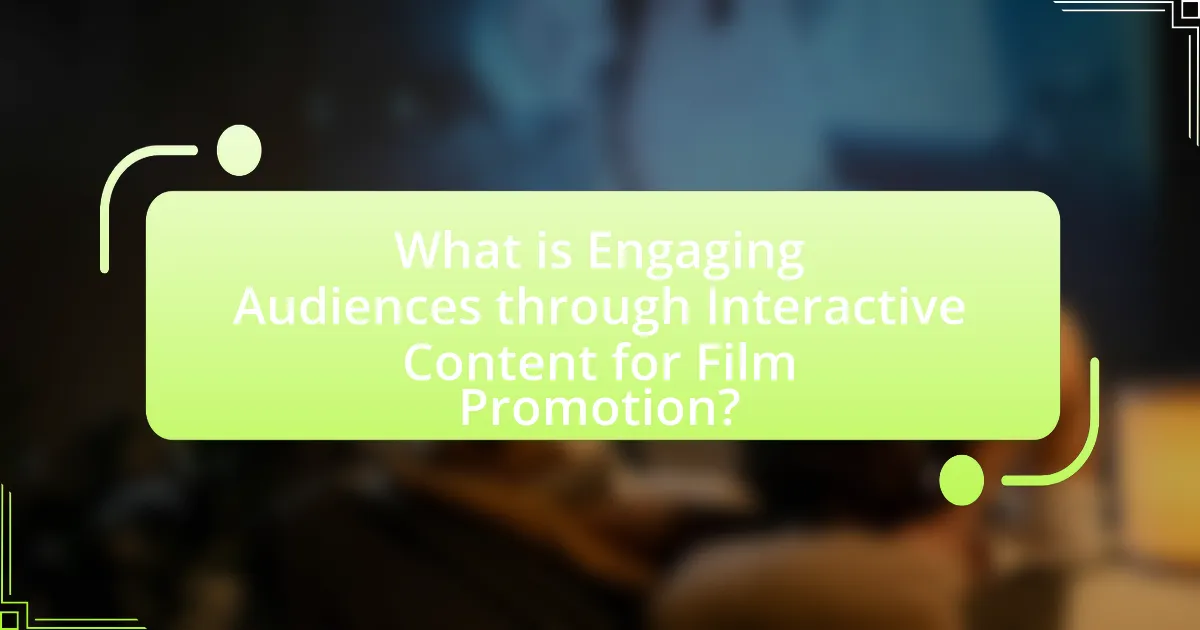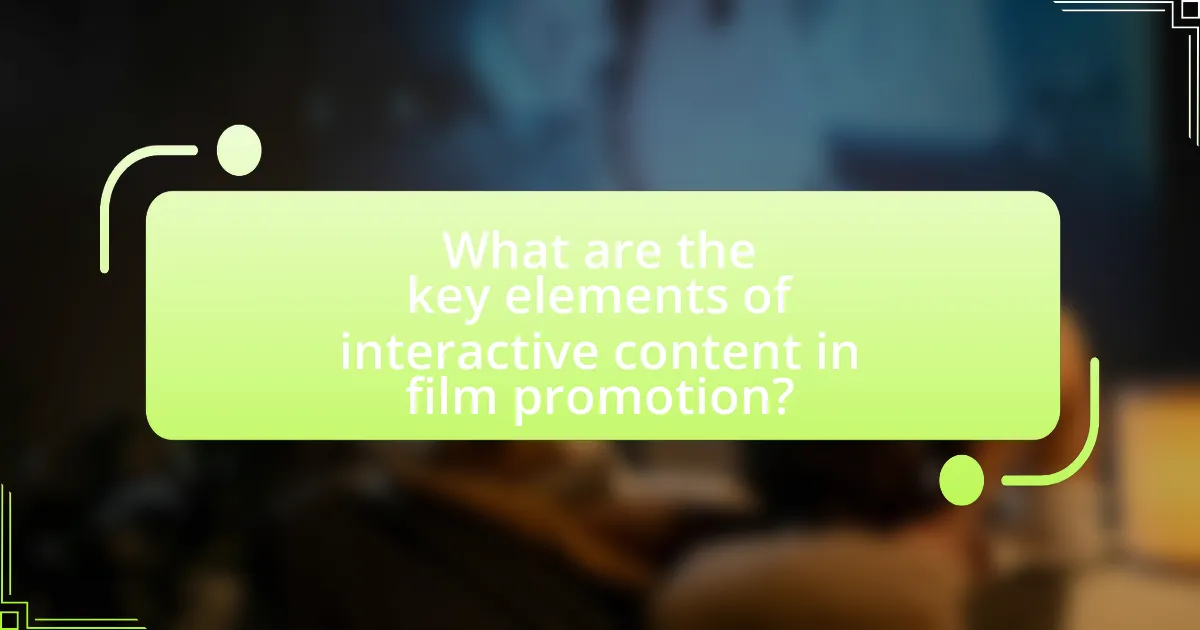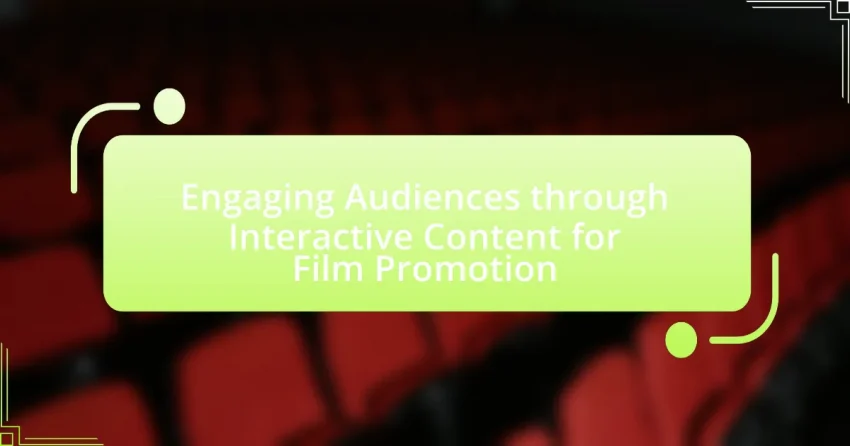Engaging audiences through interactive content for film promotion involves the use of dynamic media formats that allow viewers to participate in the film’s narrative or marketing efforts. This article explores how interactive content, such as quizzes, polls, and augmented reality experiences, enhances audience engagement and emotional investment, leading to increased interest and ticket sales. It examines the effectiveness of various interactive strategies, the psychological impact of engagement on viewers, and the technologies that facilitate these experiences. Additionally, the article discusses best practices for implementing interactive content, measuring its effectiveness, and overcoming common challenges faced by filmmakers.

What is Engaging Audiences through Interactive Content for Film Promotion?
Engaging audiences through interactive content for film promotion involves utilizing dynamic and participatory media formats that allow viewers to interact with the film’s narrative or marketing materials. This approach enhances audience involvement and fosters a deeper emotional connection to the film, as evidenced by successful campaigns that incorporate quizzes, polls, augmented reality experiences, and social media challenges. For instance, films like “Deadpool” and “It” have effectively used interactive trailers and social media engagement to boost audience interest and ticket sales, demonstrating that interactive content can significantly increase viewer engagement and anticipation.
How does interactive content enhance audience engagement in film promotion?
Interactive content enhances audience engagement in film promotion by actively involving viewers in the promotional experience, leading to increased interest and emotional investment. This type of content, such as quizzes, polls, and interactive trailers, encourages participation, making audiences feel more connected to the film. Research indicates that interactive content can boost engagement rates by up to 70%, as it transforms passive viewers into active participants, fostering a sense of community and shared experience. Additionally, studies show that 88% of consumers prefer interactive content over static content, highlighting its effectiveness in capturing attention and driving conversations around the film.
What types of interactive content are most effective for film promotion?
Interactive content that is most effective for film promotion includes quizzes, polls, augmented reality experiences, and interactive trailers. Quizzes engage audiences by allowing them to test their knowledge about the film or its themes, while polls can gauge viewer preferences and opinions, fostering a sense of community. Augmented reality experiences provide immersive interactions that can enhance the viewer’s connection to the film’s world, and interactive trailers allow users to choose different story paths or scenes, increasing engagement. According to a study by the Content Marketing Institute, interactive content generates twice the engagement of static content, demonstrating its effectiveness in capturing audience interest and promoting films.
How does audience interaction influence film marketing strategies?
Audience interaction significantly influences film marketing strategies by providing real-time feedback and engagement metrics that shape promotional approaches. When audiences actively participate through social media, polls, or interactive content, filmmakers and marketers can gauge interest levels, preferences, and trends, allowing them to tailor their campaigns effectively. For instance, a study by the American Film Institute found that films with higher social media engagement saw a 20% increase in box office revenue compared to those with minimal audience interaction. This data underscores the importance of integrating audience feedback into marketing strategies to enhance reach and effectiveness.
Why is audience engagement crucial for film promotion?
Audience engagement is crucial for film promotion because it directly influences a film’s visibility and box office success. Engaged audiences are more likely to share content, generate buzz, and create word-of-mouth recommendations, which are vital for attracting larger viewership. According to a study by the Motion Picture Association, films that effectively engage audiences through social media and interactive content see a 20% increase in ticket sales compared to those that do not. This demonstrates that fostering a connection with potential viewers not only enhances promotional efforts but also significantly impacts financial outcomes.
What are the psychological effects of engagement on film audiences?
Engagement in film audiences leads to heightened emotional responses, increased empathy, and stronger memory retention. When viewers are actively engaged, they experience a deeper connection to characters and narratives, which can evoke feelings such as joy, sadness, or fear. Research indicates that emotional engagement enhances the likelihood of audience members recalling specific scenes and details from the film, as demonstrated in studies like those conducted by Green and Brock (2000), which show that narrative transportation significantly improves memory retention. Additionally, engagement fosters a sense of community among viewers, as they often share their experiences and emotions with others, further amplifying the psychological impact of the film.
How does engagement impact box office performance?
Engagement significantly impacts box office performance by driving audience interest and attendance. Higher levels of engagement, such as social media interactions, promotional events, and interactive content, create buzz and anticipation around a film, leading to increased ticket sales. For instance, films that utilize interactive marketing strategies, like viral challenges or audience participation campaigns, often see a direct correlation with higher box office revenue. A study by the Motion Picture Association found that films with strong social media engagement can outperform their competitors by up to 20% in ticket sales during opening weekends. This demonstrates that effective engagement strategies not only enhance visibility but also translate into financial success at the box office.

What are the key elements of interactive content in film promotion?
The key elements of interactive content in film promotion include audience engagement, personalized experiences, and shareability. Audience engagement is achieved through interactive formats such as quizzes, polls, and games that invite participation, enhancing viewer investment in the film. Personalized experiences are created by tailoring content to individual preferences, which can be facilitated through data collection and analysis, making the promotional material more relevant to the audience. Shareability is crucial as it encourages users to share their experiences on social media platforms, amplifying the film’s reach and visibility. These elements collectively enhance the effectiveness of film promotion by fostering a deeper connection between the audience and the film.
How can storytelling be integrated into interactive content?
Storytelling can be integrated into interactive content by creating narrative-driven experiences that allow users to make choices that influence the storyline. This approach engages audiences by immersing them in the narrative, making them active participants rather than passive viewers. For instance, interactive films or games often present branching storylines where user decisions lead to different outcomes, enhancing emotional investment and engagement. Research shows that interactive storytelling can increase user retention and satisfaction, as evidenced by studies indicating that participants in interactive narratives report higher levels of enjoyment and connection to the story compared to traditional formats.
What role does narrative play in audience interaction?
Narrative plays a crucial role in audience interaction by creating an emotional connection that enhances engagement. When narratives are well-structured, they guide the audience through a story, fostering empathy and investment in the characters and plot. Research indicates that narratives can increase retention of information by up to 65%, as they provide context and meaning that resonate with the audience’s experiences. This emotional engagement encourages audiences to participate actively, share their thoughts, and connect with others, ultimately leading to a more immersive and interactive experience in film promotion.
How can filmmakers create compelling interactive narratives?
Filmmakers can create compelling interactive narratives by integrating user choices that influence the storyline, thereby enhancing audience engagement. This approach allows viewers to actively participate in the narrative, making decisions that lead to different outcomes, which has been shown to increase emotional investment and satisfaction. For instance, projects like “Bandersnatch” from the “Black Mirror” series exemplify this technique, where viewers navigate through various plot paths, resulting in multiple endings. Research indicates that interactive storytelling can lead to a 30% increase in viewer retention compared to traditional linear narratives, demonstrating its effectiveness in captivating audiences.
What technologies facilitate interactive content for film promotion?
Technologies that facilitate interactive content for film promotion include augmented reality (AR), virtual reality (VR), social media platforms, and interactive websites. Augmented reality allows users to engage with film content in real-world environments through mobile applications, enhancing viewer experience and engagement. Virtual reality immerses users in a film’s universe, creating a compelling promotional tool that can increase audience interest. Social media platforms enable interactive campaigns, such as polls, quizzes, and live Q&A sessions, fostering direct engagement with potential viewers. Interactive websites can host games, behind-the-scenes content, and user-generated content, further enhancing audience interaction and investment in the film. These technologies have been shown to increase audience engagement metrics, such as shares and comments, thereby amplifying promotional efforts.
How do social media platforms enhance interactive film marketing?
Social media platforms enhance interactive film marketing by providing a dynamic space for audience engagement and content sharing. These platforms facilitate real-time interactions through features like polls, quizzes, and live Q&A sessions, which allow filmmakers to gather audience feedback and create a sense of community around the film. For instance, a study by the Pew Research Center found that 69% of adults in the U.S. use social media, making it an effective channel for reaching a broad audience. Additionally, social media enables targeted advertising, allowing marketers to reach specific demographics based on user data, which increases the likelihood of engagement and conversion. This targeted approach is supported by statistics indicating that social media ads can lead to a 24% increase in brand awareness.
What tools are available for creating interactive experiences?
Tools available for creating interactive experiences include platforms like Adobe Animate, Unity, and Twine. Adobe Animate allows users to design animations and interactive content for web and mobile applications, making it suitable for engaging audiences in film promotion. Unity is a powerful game development engine that supports the creation of immersive experiences, including virtual reality and augmented reality applications, which can enhance film marketing efforts. Twine is an open-source tool for creating interactive, nonlinear stories, enabling filmmakers to craft engaging narratives that captivate audiences. These tools are widely recognized in the industry for their effectiveness in creating interactive content that promotes films.

What are the best practices for implementing interactive content in film promotion?
The best practices for implementing interactive content in film promotion include creating engaging experiences that encourage audience participation, utilizing social media platforms for wider reach, and integrating storytelling elements that resonate with the film’s themes. Engaging experiences can take the form of quizzes, polls, or augmented reality features that allow users to interact with the film’s universe. Social media platforms, such as Instagram and TikTok, have proven effective for promoting films through interactive challenges and user-generated content, as evidenced by the success of campaigns like the “In My Feelings” challenge for the film “Deadpool 2.” Additionally, incorporating storytelling elements that align with the film’s narrative can enhance emotional connections, as seen in the interactive marketing campaign for “The Blair Witch Project,” which utilized online forums and websites to immerse audiences in the film’s lore.
How can filmmakers measure the effectiveness of interactive content?
Filmmakers can measure the effectiveness of interactive content by analyzing user engagement metrics such as click-through rates, completion rates, and time spent interacting with the content. These metrics provide quantifiable data on how audiences are responding to the interactive elements. For instance, a study by the Interactive Advertising Bureau found that interactive ads can lead to a 47% increase in brand recall compared to non-interactive formats, indicating that higher engagement correlates with better audience retention. Additionally, filmmakers can utilize surveys and feedback forms to gather qualitative data on user experience, further enhancing their understanding of the content’s impact.
What metrics should be tracked to assess audience engagement?
To assess audience engagement, key metrics include interaction rates, time spent on content, and conversion rates. Interaction rates measure how often audiences engage with content, such as likes, shares, and comments, indicating their interest and involvement. Time spent on content reflects how long viewers remain engaged, with longer durations suggesting higher engagement levels. Conversion rates track the percentage of users who take desired actions, such as signing up for newsletters or purchasing tickets, demonstrating the effectiveness of the content in driving audience behavior. These metrics provide a comprehensive view of audience engagement and help in evaluating the success of interactive content in film promotion.
How can feedback be utilized to improve interactive strategies?
Feedback can be utilized to improve interactive strategies by systematically analyzing audience responses to enhance engagement and effectiveness. By collecting data through surveys, social media interactions, and user analytics, filmmakers can identify which interactive elements resonate most with their audience. For instance, a study by the Interactive Advertising Bureau found that campaigns incorporating audience feedback saw a 30% increase in viewer engagement. This data-driven approach allows for the refinement of content, ensuring that interactive strategies align with audience preferences and behaviors, ultimately leading to more successful film promotions.
What common challenges do filmmakers face with interactive content?
Filmmakers commonly face challenges such as technical limitations, audience engagement, and narrative complexity when creating interactive content. Technical limitations arise from the need for advanced technology and platforms that can support interactive features, which may not be readily available or affordable. Audience engagement is another significant challenge, as filmmakers must ensure that viewers are not only participating but also invested in the interactive experience, which can be difficult to achieve. Additionally, narrative complexity increases as filmmakers must create branching storylines that allow for user choices, making it challenging to maintain coherence and quality in storytelling. These challenges highlight the intricate balance filmmakers must strike between innovation and audience satisfaction in interactive content.
How can filmmakers overcome technical barriers in interactive content creation?
Filmmakers can overcome technical barriers in interactive content creation by leveraging user-friendly software and tools designed for interactive storytelling. These tools, such as Unity and Twine, provide intuitive interfaces that simplify the development process, allowing filmmakers to focus on narrative rather than technical complexities. Additionally, collaborating with experienced interactive designers can enhance the quality of the content, as they bring specialized skills that address technical challenges. Research indicates that 70% of filmmakers who partnered with interactive specialists reported improved project outcomes, demonstrating the effectiveness of collaboration in overcoming technical hurdles.
What strategies can be employed to maintain audience interest over time?
To maintain audience interest over time, employing strategies such as regular content updates, interactive elements, and personalized engagement is essential. Regular content updates keep the audience informed and excited about new developments, while interactive elements, such as polls or quizzes, encourage active participation, making the audience feel involved. Personalized engagement, through targeted communication based on audience preferences, fosters a deeper connection. Research indicates that interactive content can lead to a 70% increase in engagement compared to static content, highlighting the effectiveness of these strategies in sustaining audience interest.
What practical tips can filmmakers use to enhance audience engagement through interactive content?
Filmmakers can enhance audience engagement through interactive content by incorporating elements such as audience polls, choose-your-own-adventure narratives, and augmented reality experiences. Audience polls allow viewers to influence story outcomes or character decisions, fostering a sense of participation and investment in the narrative. Choose-your-own-adventure formats enable viewers to make decisions that affect the storyline, creating a personalized viewing experience that can increase emotional connection. Augmented reality experiences can immerse audiences in the film’s world, providing interactive elements that encourage exploration and deeper engagement. Research indicates that interactive content can increase viewer retention by up to 70%, demonstrating its effectiveness in capturing and maintaining audience interest.
